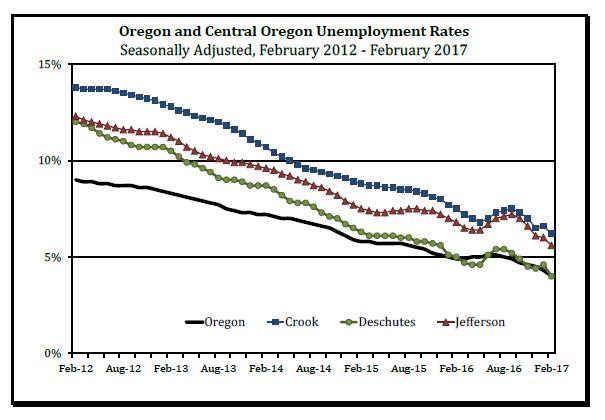BEND, OR -- Deschutes County’s unemployment rate has hit its lowest point since records began 27 years ago. The jobless rate fell to 4% in February; the .6% drop from January is also tied with the largest monthly decline since 1990.
Regional economist Damon Runberg says the Deschutes County rate is now in line with the 4% statewide average. "We tend to see Central Oregon numbers quite a bit above the statewide the average. So, to see Deschutes County catch up to the state, and have one of the lowest rates in the state right now, is pretty impressive. It really says something about how fast our job growth has been sustained over the last couple of years." He tells KBND News, "The metropolitan areas in the state - so we’re talking places like Portland, Eugene, Salem, Bend, etc. - There’s been just exceptionally fast job growth and those big, populated areas are driving the statewide numbers. So, we’re not seeing nearly as positive of figures in rural Oregon, today. But, like I said – in the Portland metro area, right now, for instance, the unemployment rate is 3.5%."
While rural areas aren't growing as fast, Runberg says Crook and Jefferson counties also saw improvements, "Our rural communities also saw significant drops in our unemployment rate, too. Now, they’re not at historically low levels, like we are in Deschutes County, they’re well below their long-term average that we typically see for these rural communities but still really impressive drops. The rates are 6.2% in Crook County and 5.6% in Jefferson County."
Deschutes County added nearly 800 jobs in February; Jefferson County added 50 jobs. Crook County saw no significant hiring, which Runberg says means those residents likely found work in Deschutes County. He says it’s too early to know whether the rapid job growth in the region is a trend. "We are a very, very seasonally influenced economy in Central Oregon. So, some of the monthly figures can get a little sideways if one of those layoff events or hiring events that we typically see happens a little earlier or later in the year. I would try to shy away from leaning too heavy into the one-month data in saying ‘it’s a huge trend that we should pay attention to.’ I think if we continue to see this in the short run, and the next two to three months, then it will be particularly impressive if we maintain these levels." And he notes that a rate much lower than 4% can lead to higher costs of goods and services to compensate for higher wages paid in such a tight labor market.




